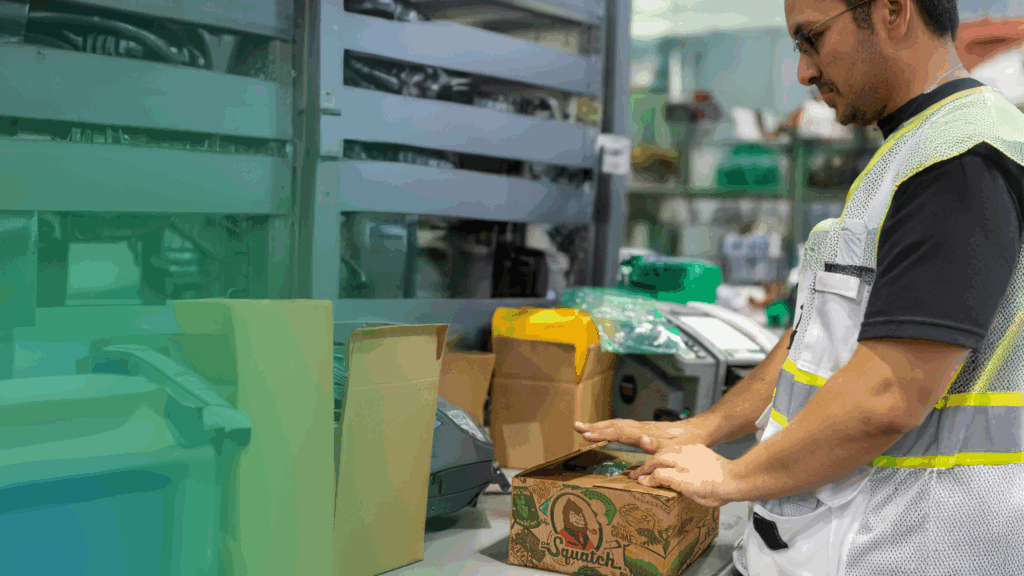When analyzing product sales in your business, you’re bound to find some SKUs that just won’t budge from your warehouse shelves. While it is vital to focus on top-selling items to capitalize on your strengths and generate more income, you can do your company a huge disservice if you’re ignoring your slow-moving inventory. In this article, we’ll share a variety of strategies your company can use to reduce the impact of slow-moving products or get rid of them entirely.
If your company has an inventory manager, he or she can easily explain why slow-moving inventory is such a big problem:
- Slow-moving inventory commands precious real estate on your warehouse shelves, preventing room for faster-selling products.
- Stale products tie up your company’s financial capital, which can cause more complications for your business.
Your business will become more efficient – and more profitable – by reducing slow-moving inventory. First, you’ll need to determine how your company qualifies an item as “slow-moving.” The criteria your company uses to define slow-moving inventory (SMI) can vary drastically from a company in another industry.
Generally speaking, slow-moving inventory is defined as goods that are sitting on the shelves of your warehouse for longer than a specific amount of time. If a SKU (stock-keeping unit) has been sitting for more than the predetermined time period, it is considered stale or slow-moving. The time period may be 90 days, 120 days, or 180 days, depending on the product in question. Identify your company’s specific criteria and pull up a report of all slow-moving SKUs. Now, we’ll get into the causes and solutions.
What caused your slow-moving inventory?
When any relationship isn’t working out, it’s time to take a deeper look and figure out the real reason why. The same goes for your company’s relationship with its products. The question becomes: Is it the product, or is it you? More specifically, is your slow-moving inventory a result of your website, product page, marketing, or branding?
Inventory Management
Without pointing fingers, we need to analyze the source of the inventory issue. Here are some questions to discuss with your team:
- Why were your sales forecasts off?
- Was there a correlating event in your market, such as a competing product launch? Did a competitor drop their prices? If your company tracks marketing data such as campaigns and events, review it alongside your sales data.
- Is your price competitive, and is your product value proposition clear?
- Is demand seasonal?
- Were your initial shipments late, and a competitor received their stock first?
- Is a competitor investing heavily in targeted advertising?
- Is the item outdated compared to newer options in your industry?
- Did your inventory manager order too much of an item as a way to lower cost-per-item?
You may need to update your forecasting tools or strategy for more advanced tracking of inventory and demands.
Website Layout & Navigation
Your website should be your best employee and your most efficient sales tool. Just like your human resources, your website should receive regular performance reviews to ensure it’s performing as expected. Once you’ve identified slow-moving products, review their position on your website. Things to look for include:
- Are links, redirects, and the search bar functioning properly?
- Are the slow-moving products easily found on your website?
- Are they categorized correctly?
- Can they be re-merchandized and placed more prominently within individual categories or search results?
- Which web pages receive the most traffic? Can you use those pages to promote slow-moving inventory?
If your website offers more than a few dozen products, slow-moving products may be due to lower visibility on your website. If positioning is a factor, then optimizing your merchandising strategy may be a quick and inexpensive way to improve inventory turn-over.
Adjust search results to populate slow-moving items when customers seek top-selling items. Target a specific shopper persona, and consider optimizing retargeting strategies on your website to guide the customer’s journey.
Product Page
Once you’ve optimized your website, let’s review individual product pages for stale SKUs. Sales are influenced by how well the product is represented. If a product sales page is lacking vital information, customers may not complete a transaction. Items to review include:
Images & Description
- Are product photos compelling?
- Are the images clear and high quality?
- Are there images from multiple angles?
Product Descriptions
- Should the product title be adjusted?
- Is the product description clear and informative?
- Is the copy up-to-date and free of errors?
- Have you communicated product specifications, features and benefits?
- Have you included answers to frequently asked questions?
- Would customers benefit from a short product video?
When your customer service team receives questions about these products, use the answers used to optimize the product copy and ensure customers have all the information they require to make their purchase.
Metadata & SEO
- Is the backend of your product pages completed with all necessary and true metadata?
- Are keywords optimized for SEO?
- Are product search filters correct?
Stale inventory still won’t budge?
If you’ve determined that a product’s low sales volume is attributed to the product itself, it’s time to let go of the inventory. Depending on how quickly you want to free up the capital, you have a variety of options to release the SKUs in a way that protects your bottom line.
Promotional Campaigns
Email Marketing
Review customers who have purchased the slow-moving products. Who are they? Why did they buy? Once you understand the customer segments, use email marketing campaigns to target likely buyers. Incentivize customers to click-through to purchase with a coupon or promotion.
Product Bundles
There are various options to bundle your product in a way that will be more compelling to customers. Slow-moving inventory can be bundled with fast-selling products to incentivize a purchase. Alternatively, multiple slow-moving SKUs can be bundled together to increase average order value (AOV) while promoting multiple items. For example, if your slow-moving inventory includes shirts and hats, you may combine shirts and hats into one bundle, or create bundles of 2 or more shirts.
Bundles should be comprised of complementary products. For example, a tech retailer wanting to sell more bluetooth headphones may bundle them with the sale of smartphones or laptops.
Discounts
Discounts are another great opportunity to promote stale products via targeted email and social media campaigns. Some options for discounting include:
- Clearance sales
- Price drops
- Daily deals
- Flash sales
- Seasonal sales
- Low-price add-ons
Gifts
Using slow-moving products for free bonus gifts or social media giveaways can be a great opportunity to build brand awareness and customer loyalty. If your stale inventory makes a good gift, consider giving to your employees and network! Another option is to offer stale SKUs as a free gift with a minimum purchase requirement to increase average order value (AOV).
Product Liquidation
Some retailers may be able to negotiate buy-back from manufacturers in exchange for credit. If that is not an option, there are still other possibilities to soften the financial loss of slow-moving inventory.
Marketplaces
Marketplaces such as eBay and other deal sites can open your products up to a different audience.
Incentivize sales
Consider incentivizing your sales staff and customer service team with bonuses or prizes for selling slow-moving inventory.
Liquidators
If liquidators are interested in your products, this may be the quickest and most efficient way to clear shelf space and put some capital into faster-selling products.
Barter
Utilize your company’s relationships within and outside your industry to seek opportunities for a mutually beneficial barter of products or services. Get creative!
Donate
Finally, consider donating slow-moving inventory. Donating is an opportunity to put your money where your corporate values are. This socially-conscious option doubles as a prime opportunity to create marketing content that shares your company’s story with customers. For example, a clothing company may donate slow-moving socks and undershirts to a shelter for homeless veterans. An act of charity is absolutely priceless. You may even be eligible for a tax deduction.
Which option is right for your slow-moving inventory?
Stale inventory and slow-moving products are inevitable in most businesses, but this is just another opportunity for your company to learn and pivot. The strategies listed above can be used as a gateway to unleash creative ideas that can ultimately strengthen your company’s brand and bottom line.
What does your company do with slow-moving inventory? Email us your tips to be featured on our blog!





